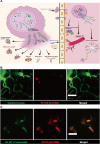Real-time observation of neutrophil extracellular trap formation in the inflamed mouse brain via two-photon intravital imaging
- PMID: 35698178
- PMCID: PMC9190083
- DOI: 10.1186/s42826-022-00126-3
Real-time observation of neutrophil extracellular trap formation in the inflamed mouse brain via two-photon intravital imaging
Abstract
Intravital imaging via two-photon microscopy (TPM) is a useful tool for observing and delineating biological events at the cellular and molecular levels in live animals in a time-lapse manner. This imaging method provides spatiotemporal information with minimal phototoxicity while penetrating a considerable depth of intact organs in live animals. Although various organs can be visualized using intravital imaging, in the field of neuroscience, the brain is the main organ whose cell-to-cell interactions are imaged using this technique. Intravital imaging of brain disease in mouse models acts as an abundant source of novel findings for studying cerebral etiology. Neutrophil infiltration is a well-known hallmark of inflammation; in particular, the crucial impact of neutrophils on the inflamed brain has frequently been reported in literature. Neutrophil extracellular traps (NETs) have drawn attention as an intriguing feature over the last couple of decades, opening a new era of research on their underlying mechanisms and biological effects. However, the actual role of NETs in the body is still controversial and is in parallel with a poor understanding of NETs in vivo. Although several experimental methods have been used to determine NET generation in vitro, some research groups have applied intravital imaging to detect NET formation in the inflamed organs of live mice. In this review, we summarize the advantages of intravital imaging via TPM that can also be used to characterize NET formation, especially in inflamed brains triggered by systemic inflammation. To study the function and migratory pattern of neutrophils, which is critical in triggering the innate immune response in the brain, intravital imaging via TPM can provide new perspectives to understand inflammation and the resolution process.
Keywords: Brain; Intravital imaging; Neutrophil; Neutrophil extracellular trap; Two-photon microscopy.
© 2022. The Author(s).
Conflict of interest statement
The authors declare that they have no competing interests.
Figures


Similar articles
-
NLRP3 Exacerbate NETosis-Associated Neuroinflammation in an LPS-Induced Inflamed Brain.Immune Netw. 2023 May 8;23(3):e27. doi: 10.4110/in.2023.23.e27. eCollection 2023 Jun. Immune Netw. 2023. PMID: 37416934 Free PMC article.
-
Imaging of Neutrophils and Neutrophil Extracellular Traps (NETs) with Intravital (In Vivo) Microscopy.Methods Mol Biol. 2020;2087:443-466. doi: 10.1007/978-1-0716-0154-9_26. Methods Mol Biol. 2020. PMID: 31729004
-
Imaging the neutrophil: Intravital microscopy provides a dynamic view of neutrophil functions in host immunity.Cell Immunol. 2020 Apr;350:103898. doi: 10.1016/j.cellimm.2019.01.003. Epub 2019 Jan 23. Cell Immunol. 2020. PMID: 30712753 Review.
-
In Vivo Imaging of Circadian NET Formation During Lung Injury by Four-Dimensional Intravital Microscopy.Methods Mol Biol. 2022;2482:285-300. doi: 10.1007/978-1-0716-2249-0_19. Methods Mol Biol. 2022. PMID: 35610434
-
Therapeutic Targeting of Neutrophil Granulocytes in Inflammatory Liver Disease.Front Immunol. 2019 Sep 20;10:2257. doi: 10.3389/fimmu.2019.02257. eCollection 2019. Front Immunol. 2019. PMID: 31616430 Free PMC article. Review.
Cited by
-
NLRP3 Exacerbate NETosis-Associated Neuroinflammation in an LPS-Induced Inflamed Brain.Immune Netw. 2023 May 8;23(3):e27. doi: 10.4110/in.2023.23.e27. eCollection 2023 Jun. Immune Netw. 2023. PMID: 37416934 Free PMC article.
-
NLRP3 exacerbates EAE severity through ROS-dependent NET formation in the mouse brain.Cell Commun Signal. 2024 Feb 2;22(1):96. doi: 10.1186/s12964-023-01447-z. Cell Commun Signal. 2024. PMID: 38308301 Free PMC article.
-
A Brief Overview of Neutrophils in Neurological Diseases.Biomolecules. 2023 Apr 25;13(5):743. doi: 10.3390/biom13050743. Biomolecules. 2023. PMID: 37238612 Free PMC article. Review.
References
Publication types
Grants and funding
LinkOut - more resources
Full Text Sources

